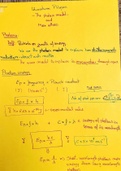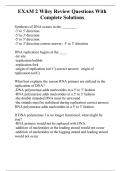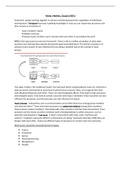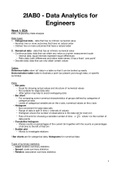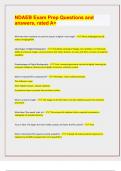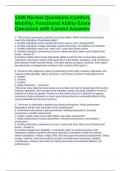Algorithms in sequence analysis lecture 1
Exam Tuesday 19-12 8:30-10:45 50% (multiple choice)
Evolution has four requirements:
1. Template structure providing stability (DNA)
2. Copying mechanism (meiosis)
3. Error: mechanism providing variation (mutations: insertions and deletions; crossing-
over)
4. Selection: some traits lead to greater fitness of one individual relative to another.
Darwin quoted ‘survival of the fittest’.
Evolution is a conservative process: the vast majority of mutations will not be selected. This
is called negative (or purifying) selection.
Natural selection
• Acts on the phenotype, the characteristics of the organism which actually interact
with the environment.
• The genetic (heritable) basis of any phenotype is the genotype, that gives that
phenotype a reproductive advantage may become more common in a population.
• Intracellular processes may lead to DNA alterations but also the environment.
Environment: the Exposome
Three overlapping components of the exposome of humans:
1. A general external environment including the urban environment, education, climate
factors, social capital, pollution.
2. A specific external environment with specific contaminants, radiation, infections,
lifestyle factors (tobacco, alcohol), diet, physical activity.
3. An internal environment to include internal biological factors such as metabolic
factors, hormones, gut and oral microbiota, inflammation, oxidative stress.
Homology (common ancestry, homologous genes have a common ancestor)
1. Orthologous genes are homologous: Genes in different species, relating to a
speciation event. Corresponding gene in other organism.
2. Paralogous genes are homologous genes: Repeats within the same species,
relating to a duplication event. After duplication the selection pressure goes
down, over time it will rise again. Low selection pressure on duplicated genes
allows mutations and genetic drift to increase. Duplication is really important.
BAD = burst after duplication.
Xenology- horizontal transfer
Horizontal gene transfer (HGT) also called lateral gene transfer (LGT) is any processs in
which an organism incorporates genetic material from another organism without being the
offspring of that organism. Vertical transfer occurs when an organism receives genetic
material from its ancestor, its parent or a species from which it evolved.
Transition: purine → purine or pyrimidine → pyrimidine
,Transversion: purine → pyrimidine or other way around.
Types of point mutations:
1. Synonymous mutation: mutations that does not lead to an amino acid change in the
protein product.
2. non-synonymous mutation: does lead to an amino acid change.
1. Missense mutation: one a.a replaced by another one.
2. Nonsense mutation: a.a. replaced by stop codon.
Transposons are sequences of DNA that can move around to different positions within the
genome of a single cell, a process called transposition. These can cause mutations and
change the amount of DNA in the genome.
1. Class 1: mobile genetic elements, retrotransposons, move in the genome by being
transcribed to RNA and then back to DNA by reverse transcriptase. Can make
multiple copies.
2. Class 2: mobile genetic elements move directly from one position to another within
the genome using a transposase to cut and paste them within the genome.
Sequence encodes structure encodes function. Genotype is sequence and phenotype
structure and function.
If an analogous protein resulting from divergent evolution takes over function in cell this is
called non-orthologous replacement.
,Lecture 2 pairwise alignment
• The time complexity is O(n^2),
i.e. order of n^2: for aligning two
sequences of n residues, you need
to perform n 2 algorithmic steps
(square search matrix has n^2
cells that need to be filled)
• The memory (space) complexity
is also O(n^2): for aligning two
sequences of n residues, you need
a square search matrix of n by n
containing n^2 cells.
,
Exam Tuesday 19-12 8:30-10:45 50% (multiple choice)
Evolution has four requirements:
1. Template structure providing stability (DNA)
2. Copying mechanism (meiosis)
3. Error: mechanism providing variation (mutations: insertions and deletions; crossing-
over)
4. Selection: some traits lead to greater fitness of one individual relative to another.
Darwin quoted ‘survival of the fittest’.
Evolution is a conservative process: the vast majority of mutations will not be selected. This
is called negative (or purifying) selection.
Natural selection
• Acts on the phenotype, the characteristics of the organism which actually interact
with the environment.
• The genetic (heritable) basis of any phenotype is the genotype, that gives that
phenotype a reproductive advantage may become more common in a population.
• Intracellular processes may lead to DNA alterations but also the environment.
Environment: the Exposome
Three overlapping components of the exposome of humans:
1. A general external environment including the urban environment, education, climate
factors, social capital, pollution.
2. A specific external environment with specific contaminants, radiation, infections,
lifestyle factors (tobacco, alcohol), diet, physical activity.
3. An internal environment to include internal biological factors such as metabolic
factors, hormones, gut and oral microbiota, inflammation, oxidative stress.
Homology (common ancestry, homologous genes have a common ancestor)
1. Orthologous genes are homologous: Genes in different species, relating to a
speciation event. Corresponding gene in other organism.
2. Paralogous genes are homologous genes: Repeats within the same species,
relating to a duplication event. After duplication the selection pressure goes
down, over time it will rise again. Low selection pressure on duplicated genes
allows mutations and genetic drift to increase. Duplication is really important.
BAD = burst after duplication.
Xenology- horizontal transfer
Horizontal gene transfer (HGT) also called lateral gene transfer (LGT) is any processs in
which an organism incorporates genetic material from another organism without being the
offspring of that organism. Vertical transfer occurs when an organism receives genetic
material from its ancestor, its parent or a species from which it evolved.
Transition: purine → purine or pyrimidine → pyrimidine
,Transversion: purine → pyrimidine or other way around.
Types of point mutations:
1. Synonymous mutation: mutations that does not lead to an amino acid change in the
protein product.
2. non-synonymous mutation: does lead to an amino acid change.
1. Missense mutation: one a.a replaced by another one.
2. Nonsense mutation: a.a. replaced by stop codon.
Transposons are sequences of DNA that can move around to different positions within the
genome of a single cell, a process called transposition. These can cause mutations and
change the amount of DNA in the genome.
1. Class 1: mobile genetic elements, retrotransposons, move in the genome by being
transcribed to RNA and then back to DNA by reverse transcriptase. Can make
multiple copies.
2. Class 2: mobile genetic elements move directly from one position to another within
the genome using a transposase to cut and paste them within the genome.
Sequence encodes structure encodes function. Genotype is sequence and phenotype
structure and function.
If an analogous protein resulting from divergent evolution takes over function in cell this is
called non-orthologous replacement.
,Lecture 2 pairwise alignment
• The time complexity is O(n^2),
i.e. order of n^2: for aligning two
sequences of n residues, you need
to perform n 2 algorithmic steps
(square search matrix has n^2
cells that need to be filled)
• The memory (space) complexity
is also O(n^2): for aligning two
sequences of n residues, you need
a square search matrix of n by n
containing n^2 cells.
,


